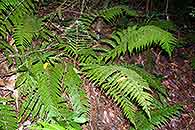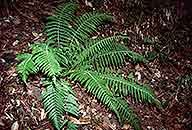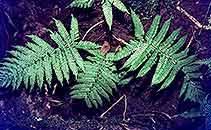Ctenitis cirrhosa (Schumach.) Ching
Synonyms |
Aspidium cirrhosum Schumach. |
|---|---|
Common name |
|
Description |
Rhizome erect or ascending, rarely short creeping; rhizome scales 7-20 x 1-1.2 mm, entire but with few marginal gland-tipped protuberances, golden-brown, linear-attenuate to narrowly lanceolate in outline. Fronds tufted, erect to arching, thinly herbaceous. Stipe 20-50 cm long, straw-coloured above, darker at base, with dark brown scales with paler margins, linear-lanceolate, 3-10 x 0.1 mm. Lamina 2-pinnate - 2-pinnatifid, 25-100 × 30-44 cm, ovate-elongate to oblong-lanceolate in outline, acute, basal pinnae not reduced, apex gradually decrescent with more and more adnate segments. Pinnae alternate, narrowly oblong, attenuate, in 15-20+ pairs, the lowermost slightly smaller than the next pair up, minutely stalked (1-2 mm); pinnules up to 40 per pinna, very slightly falcate, sterile pinnules almost straight-sided, 20 x 4–5 mm, tip rounded, fertile pinnules spathulate, to 17 x 3 mm; margin entire, all margins with sparse transparent ± 0.8 mm long hairs; pinna costa and costule densely set with glandular hairs 0.3–0.9 mm long, tipped with orange gland that can be lost (i.e. diagnostic ctenitoid hairs), short white hairs on the veins on the upper surface and the costae & costules on the lower surface. Sori small c. 0.8 mm in diameter, round, 22-28 per lobe situated in 2 lines along the costules; indusia kidney shaped, 0.5 x 0.7 mm, brown, with minute hairs. |
Notes | Could be confused with Amauropelta bergiana which has a subglabrous rhachis & stipe (C. cirrhosa has a lower stipe which is clothed in long brown scales) and a smaller and narrower rhizome. |
Derivation | cirrhosa: bearing tendrils; referring to the long scales on the rhizome and stipe base. |
Habitat | Deeply shaded forest floors and streambanks, in moist forest. |
Distribution worldwide | Tropical Africa, Madagascar, Comoro and Mascarene Islands. |
Distribution in Africa |
Angola, Burundi, Cameroon, Central African Republic, Dem. Republic of Congo, Equatorial Guinea (incl. Bioko), Ethiopia, Ghana, Guinea, Guinea, Ivory Coast, Kenya, Liberia, Malawi, Mozambique, Sudan and South Sudan, Tanzania , Togo, Uganda, Zambia, Zimbabwe. |
Growth form |
Terrestrial. |
Literature |
|


